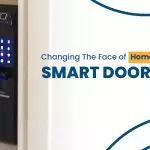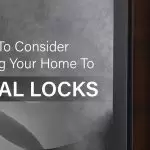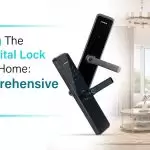Smart door locks have revolutionized home security by merging electronic and mechanical locking systems, allowing only authorized users access through authentication methods. These intelligent devices eliminate the need for traditional keys, providing a convenient and secure entry into your home.
Post your Requirement
In addition to numeric codes, advanced smart locks offer features like biometric entrance latches and fingerprint bolts, exemplified by products from reputable brands like Yale and Godrej. These high-tech options enhance security by requiring unique physical features, adding an extra layer of protection against unauthorized access.
Installing these smart bolts is made easier with models that can be fitted over existing gate latch systems, reducing the need for a complete overhaul. Furthermore, the integration of these smart locks with other home devices, such as advanced speakers or security systems, allows homeowners to create a fully connected and automated home. However, it’s essential to note that such integration often requires a home hub to connect and coordinate these devices for seamless functionality.
Shopping for these advanced door bolts is made convenient through online platforms like McCoy Mart, where you can explore a variety of options such as pin-based, biometric, and fingerprint latches. Top brands like Godrej and Yale offer reliable products, ensuring the security and convenience of your home.
How Do Smart Locks Work?
Smart locks are electrically operated locks connected to the internet and controlled through a smartphone app. They are available in both Bluetooth-only and WiFi-enabled variants.
- Bluetooth smart locks: These variants connect directly with your smartphone through Bluetooth when you are in close range, usually 30 feet. So access control and monitoring is limited to this range. They can be fitted to existing mechanical locks and operated through an app that stores user codes/credentials and controls lock functions. No separate hub/bridge is required.
- WiFi-enabled smart locks: These locks connect your smartphone to the lock through the home WiFi network, removing any range limitations. This allows full-fledged remote monitoring and control from anywhere via the Internet. For WiFi connectivity, they either have inbuilt capabilities or need an additional bridge/hub device. The hub connects to the home router via Ethernet or WiFi.
Apart from smartphones, some smart locks can also be controlled through other devices like key fobs, keypads, and wearables. Most models also retain the mechanical key override option for backup manual access.
Common Features and Specifications
When evaluating your options, here are some key features and specifications of smart locks to consider-
- Credential Options – Smart locks support various access credentials like PIN codes, key cards/fobs, biometrics (fingerprints), and smartphones via Bluetooth. Choose options suited for all intended users.
- Connectivity Protocols – As outlined earlier, connectivity would be either Bluetooth only or WiFi through an additional hub. WiFi models allow full remote access while Bluetooth works when in close range.
- Door Compatibility – Lock bodies come in various standard sizes like deadbolts, mortise locks, padlocks, etc. Ensure compatibility with your existing door, frame, handing (left/right), and dimensions.
- Door Types Supported – Main door locks, sliding door locks, garage door locks, gate locks, padlocks, etc. Make the right choice per your requirements.
- Users & Access Credentials – Review the number of unique user codes, fingerprints, etc. supported to ensure it can accommodate your family members, house help, etc.
- Alerts & Notifications: Opt for models providing notifications for activities like unlocks, locks, low battery, forced entry attempts, etc. for better monitoring.
- Auto Lock/Unlock: Auto lock gets initiated after a fixed duration if the door is not opened after unlocking. Auto unlock works when you reach home. Convenient but drains the battery faster.
- Manual Operation Provision: Check if the mechanical key override option is available as a backup during technology/battery failures.
- Power Backup: Note the battery specifications for uptime duration and replacement process. Some models support AA batteries while others have integrated rechargeable Li-ion batteries.
- Smart Home Integration: For fuller capabilities, prefer models that can integrate with other smart security and home automation devices through IFTTT, Alexa, Google Assistant, etc.
- Warranty & Support: Check warranty duration and support channels in case of any product issues.
Top Selling Smart Lock
Here are some popular smart locks to consider while making a purchase choice:
|
Smart Door Locks |
Sizes/Model |
Price |
| Yale YDR 41 Smart Door Locks For Sliding | (65 L X 20 W X 161 H) mm | Rs. 24,328 |
| Valencia Ajax Smart Door Lock with Fingerprint | (32 L X 72 W X 360 H) mm | Rs. 9,839 |
| OPEN Door Two Smart Door Lock with 5-Way Unlocking for Home or Office | (152 L x 275 H) mm | Rs. 9,000 |
| Yale YMF 40 Smart Door Lock With Biometric | (62 L X 28 W X 308 H) mm | Rs. 42,666 |
| Ozone Smart Internal Door Lock Trinity | OZ-FDL-22 BL Std Black/SC | Rs. 14,072 |
Installing Smart Locks
Follow these steps for a smooth DIY installation of your new smart lock:
- Select Installation Location: Survey all entry points and finalize one high-security door where the smart lock would come in most handy for access control. Main entrance doors are a popular choice.
- Check Door Condition: Examine the age, material (wood/metal), and current condition of the selected door and frame. Fix any issues before fitting the smart lock so that the mounting is stable and long-lasting.
- Pick Proper Smart Lock: With measurements of existing latch hardware and door thickness in hand, pick a suitable smart lock model as per compatibility. Also ensure enough credentials for storage, connectivity method, and features per your requirements.
- Gather Installation Tools: Philips screwdriver, measuring tape, pencil, drill machine (if new screw holes are needed), safety gear, etc. Also, keep the smart lock mobile app and user manual handy.
- Backup Access Means: While the smart lock is under installation, ensure at least one backup way to gain door access from outside using a key under the doormat, hidden with a neighbor, etc.
- Install Lock: Follow all instructions guiding for the physical installation of the lock cylinder, latch, strike plates, etc. from the user manual carefully. Seek help if needed to attach lock components correctly.
- Activate & Configure: Power up the lock, connect to the home WiFi network if applicable, and sync with the smartphone app to activate the unit fully. Add and configure all user credentials and customize settings for notifications, auto lock, etc.
- Test & Troubleshoot: Try access through all configured credential modes and verify proper lock/unlock operation. Fine-tune any glitches faced through the troubleshooting section of the user manual.
- Additional Automation: If pursuing an integrated smart home setup, connect the smart lock with other devices like security cameras, smart speakers, etc. through compatible ecosystems like Alexa, and Google Home for unified monitoring and control.
Smart Lock Maintenance and Safety Tips
Follow these maintenance practices for smooth long-term working of your home smart lock system:
- Protect smart locks and related hardware from dust, grease, and physical impacts during cleaning or other home maintenance work through proper covering.
- Check the battery level indicator in the smartphone app periodically and replace batteries (AA or integrated rechargeable types) as soon as notifications to avoid getting locked out. Keep spare batteries always on hand.
- Apply lubricating sprays to movable metal parts once every 6 months to silence squeaks and enhance mechanical movements. Wipe out old grease before application.
- Periodically test out all credential modes – primary phone, other registered phones, key cards, fingerprints, PIN codes, etc. to avoid unexpected access issues especially with not frequently used backup credentials.
- Always keep the provided physical key safely in a drawer to support manual override unlock during technical issues with the smart components or battery exhaustion scenarios.
- If connectivity glitches emerge, power cycle the lock, check the home WiFi router connection, try pairing the lock again with a smartphone through Bluetooth, and reboot the smartphone app to attempt resolving issues before seeking technical assistance.
Conclusion
The convenience and security of homes have significantly increased with the use of smart locks. Keyless entry systems, which have replaced traditional locks with more sophisticated technology, give consumers unmatched control and monitoring capabilities. Smart locks offer a complete solution for contemporary households with features like Bluetooth and WiFi connectivity, several credential alternatives, and integration with smart home ecosystems.
When installing a smart lock, it’s important to carefully examine things like connectivity type, door compatibility, and access credentials. Prominent companies such as Yale, Kwikset, August Home, Schlage, and Ultraloq provide a range of solutions to suit various consumer tastes and demands.
Your smart lock will continue to function smoothly if you perform routine maintenance, which includes checking the battery, lubricating the lock, and testing the credentials on occasion.























Post A Comment